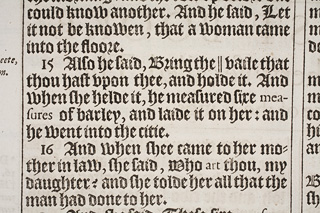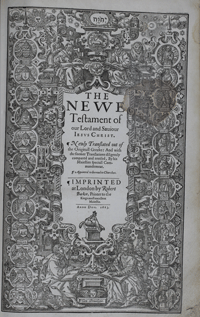The University of Canterbury is privileged to have in its possession two copies of the early KJB. One is dated to 1611 and part of the first print run. The second, a revision - but still an extraordinary work - was printed in 1613.
The first printing of the KJB is distinguished by the absence of one letter. This absence marks out Canterbury’s copy as a member of a select group. Chapter 3, verse 15 of the Book of Ruth reads in our copy ‘he went into the city’, a phrase rendered ‘she’ in every later printing in 1611.
While the decision to include 'He' in Ruth 3:15 may have been a deliberate choice on the part of the translators, it is worth noting that the King’s Printer, Robert Barker, was notorious for his errors. His most notable - although it may have been the result of sabotage - occurred in the 1631 printing. This produced the so-called ‘Wicked Bible’, where a minor slip rendered one of the commandments as ‘Thou shalt commit adultery’!
In 2010, the University was contacted by Donald Brake of Multnomah Biblical Seminary, Portland, Oregon. He was preparing the first census of 1611 ‘He’ Bibles. Dr Brake confirmed that there are only two ‘He’ Bibles in Australasia: this one, and one at the Dunedin Public Library. In 2011 the Dunedin copy was displayed as part of an exhibition held in the library's Reed Gallery.


